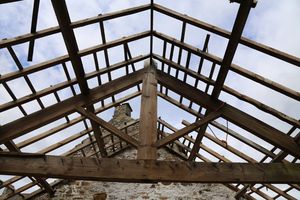Hearse House, Newbiggin: Building Survey (OASIS ID: northern1-356896)
Northern Archaeological Associates, 2019. https://doi.org/10.5284/1057521. How to cite using this DOI
Data copyright © Northern Archaeological Associates unless otherwise stated
This work is licensed under a Creative Commons Attribution 4.0 International License.
Primary contact
Northern Archaeological Associates
Marwood House
Harmire Enterprise Park
Barnard Castle
Co. Durham
DL12 8BN
Tel: 01833 690 800
Resource identifiers
- ADS Collection: 3578
- DOI:https://doi.org/10.5284/1057521
- How to cite using this DOI
Introduction

Northern Archaeological Associates Ltd. (NAA) was commissioned by Chris Dauber to undertake a Historic England Level 2 historic building survey at Newbiggin Hearse House, Newbiggin, Co. Durham (NGR: NY 91509 27532). The requirement for work was stipulated under Condition 7 of Planning Consent granted for the conversion of the listed building to accommodation (Planning Ref. DM/18/01414/FPA).
The first documentary evidence of Newbiggin dates from the medieval period, but there is evidence of settlement prior to the Norman conquest. Newbiggin grew considerably during the post-medieval period due primarily to the growth of the lead mining industry in Middleton-in-Teesdale. However, as the lead mining industry declined in the late 19th century, so too did the village and it now hosts a considerably smaller population.
The hearse house is a Grade II listed building built between 1878 and 1879 to house a hearse on the ground floor and a reading room in the upper floor. Adjacent and to the rear of the Hearse House is a blacksmithing workshop. The funding for the hearse house and reading room was raised through subscriptions and by donation of the Duke of Cleveland, the primary landowner in the area, and the London Lead Company, the area’s major employer. It is unknown when the workshop was built, but it was likely to be at a similar time. After the obsolescence of the horse drawn hearse in the early 20th century, the hearse house was used primarily for storage. The reading room was closed during the inter-war years and the stairs removed in the 1960s.
A Historic England Level 2 Historic Building Survey was carried out on the 2nd May 2019. Each distinctive building element was assigned an individual number (context number) and a photographic record was produced. Photographs of the interior and exterior were taken from as near parallel as possible, with a ranging rod for scale. These photographs were combined with field observations to create an archive and interpretation of the building.
The hearse house and workshop were constructed in single phases with minor subsequent alteration. The first floor door and window of the reading room were blocked and the stairs were removed due to safety risks some decades later. It is unknown when the hatch in the first floor was created for access, but it was probably soon after the closure of the reading room. The workshop has undergone little change save for the addition of a larger door and the demolition of some of the walls to accommodate such an alteration. The roof tiles were recently removed.
It is rare to find a hearse house with a reading room over and the building is therefore of high significance. Such a combination reflects the social mores and utilitarian needs of the villagers in the late 19th century. Moreover, the building retains an intrinsic aesthetic appeal that fits with the 19th-century character of the village. The blacksmith workshop also fits with the aesthetic character of the village and retains many of its original elements, thereby providing moderate low significance.
This building survey has provided further understanding of the development of the Newbiggin Hearse House within the wider context of the area. Considering the state of the buildings, this survey provides sufficient archaeological mitigation towards the conversion of the buildings into accommodation.





